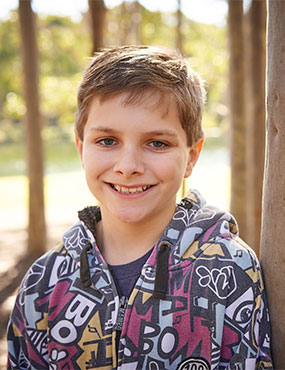New radiosurgery tool gives hope to 11 year old Jack
Jack Ottens is one of Australia’s youngest patients to have Gamma Knife treatment for a deep-brain arteriovenous malformation.

Gamma Knife treatment for young patient
An arteriovenous malformation (AVM) is an abnormal tangle of blood vessels in the brain or spine, with haemorrhage a major risk.
Melbourne-based Jack developed an AVM at the age of five. He was treated with LINAC radiosurgery, which obliterated most but not all of the mass. With the risks too high to repeat LINAC radiosurgery, doctors agreed that Gamma Knife treatment was his safest option.
“Gamma Knife surgery has revolutionised the management of many complex or inoperable brain conditions – including AVMs,” said Associate Professor John Fuller, the Macquarie University Hospital surgeon who, along with his team, performed Jack’s treatment.
“While smaller AVMs can be removed surgically, larger ones and those buried deeper in the brain are now best treated by Gamma Knife.”
“In Jack’s case, Gamma Knife presented a promising option in the absence of other viable modalities,” said Fuller.
After Jack became ill, his mother Christine spent years looking nationally and internationally for the best treatment. The family feels fortunate that Macquarie University Hospital offers Jack his best option in Gamma Knife surgery.
Macquarie University Hospital brought Gamma Knife technology to Australia ten years ago in an effort to offer patients with complex AVMs and brain tumours a new non-surgical form of treatment.
“Early data from Macquarie University Hospital’s Gamma Knife treatment for AVM shows results in line with international best practice,” explained Fuller. “International data demonstrates a very high rate of obliteration within a few years of treatment.”
Jack’s treatment at Macquarie University Hospital was made possible with support from the Monique and Doug Thompson Fund, established with a philanthropic gift from the Thompson family to provide access to the potentially life-saving treatment for those who could not otherwise afford it.